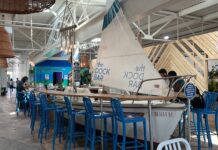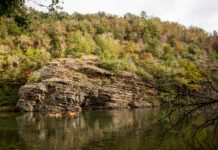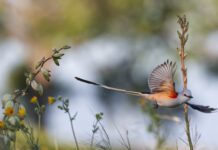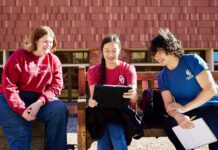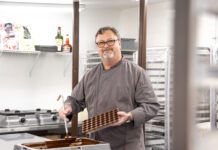Common Grounds
Oklahoma may not seem to have a lot in common with the far-off country of Ethiopia, but dark liquids are important, economically, in both areas. Here we rely on oil and there, the African nation depends on coffee.
But, perhaps surprisingly, Oklahomans helped Ethiopia develop its agricultural industry, especially concerning every nine-to-fiver’s favorite beverage: coffee.
It began with President Harry Truman’s Point Four Program, specifically aimed at helping developing countries in the areas of science and industry.
Henry Bennett, Oklahoma State University president from 1928 through 1950, headed in a new direction when approached by Truman in 1951, says his grandson, David Bennett.
“(Henry) was selected by President Truman to be the head of the Point Four Program, which has now matured into USAID,” Bennett says.
With the help of the agricultural experts at Oklahoma State, Henry Bennett established schools in Ethiopia.
“When they got to Ethiopia, the idea was to spread farming techniques, like crop rotation – stuff that they were teaching at OSU,” Bennett says.
But expectations were a little different than the Oklahomans imagined.
“They realized that the education was at such a limited stage,” Bennett says. “They had planned on establishing a college, but the locals there weren’t quite ready, so they established a high school instead.”
Associate vice president of the division of International Studies and Outreach Dr. David Henneberry says that this first high school expanded into several, which then became feeder schools for a brand new university.
From those seeds, an industry was born.
“The homepage of this university’s website still contains information about OSU and the work that was done,” Henneberry says.
Today at OSU, Henneberry says that Bennett remains a strong presence.
“Henry Bennett’s work became a legacy item for OSU that the entire campus looks to concerning not just international development, but also trade and policy,” he says.
A prominently placed statue of Bennett stands on the main green, hopefully prompting students and staff to ask about him, Henneberry adds.
Recently, documentary filmmaker and Ethiopian-American Mel Tewahade released the first installment of The Point Four, which showcases and explores the connection between Oklahoma State University and Ethiopian coffee.
Bennett says that he was impressed at the recent screening of the documentary, which focused on interviewing those involved with the Point Four Program in Ethiopia.
“(The filmmakers) didn’t talk to administrators about theoretical ideas,” Bennett says. “They interviewed people who physically went there, literally to the fields, to work with the school’s students.”
Tragically, Henry Bennett died in a plane crash in 1951, travelling for his Point Four work. However, the accomplishments that he and other Oklahomans made in Ethiopia are still bearing fruit, says his grandson.
“The connection continues today,” he says. “Ethiopians still come to Oklahoma State to learn about agriculture; there’s still that positive relationship.”
Waffle Champion
Forget the notion of eating a waffle topped with just butter and syrup, and forget about eating it with a fork and knife. Waffle Champion is revolutionizing the waffle world by wrapping their delicious, gridded cakes around fruits, vegetables, meat, eggs and confections, sometimes in common-sensical combinations, such as a ham, egg and cheese waffle, and sometimes in zany ways, like the curried beef and sweet potato. Of course, there are myriad combinations of sweet waffles topped with fruit, whipped cream and other accouterment, but that seems boring compared to a waffle stuffed with corned beef, Swiss cheese and homemade sauerkraut and topped with Thousand Island dressing, Reuben sandwich-style. Waffle Champion operates out of a food truck and uses its mobility to be seen at some of Oklahoma City’s highest-profile events, including at Oklahoma City Thunder games. They also cater to a late-night crowd. Menu changes monthly. Find out where they’re parked by following them on Twitter, @wafflechampion. 405.525.9235
Big Band Saturday Night
In the interest of full disclosure, let me say right up front that I have not only known Alan Lambert and enjoyed his work for years, but that I also host the radio show that airs right before his each Saturday night on KWGS, a.k.a. Public Radio Tulsa, at 89.5 on the FM dial. Mine is a Western swing and cowboy jazz program called Swing On This; his is Big Band Saturday Night. And while Swing On This is coming up on 10 years of weekly broadcasts, it’s an infant compared to Big Band Saturday Night, which began on Tulsa radio in the early ‘80s – making it one of the longest-lived programs in town. While Alan wasn’t there from the beginning, he was certainly already a veteran broadcaster then, having started as a teenager as the ‘60s dawned.
“I began at KFMJ, which is now KGTO,” he says. “I was a junior at Rogers High School in Tulsa. Then I started doing a nighttime show on KOME, kind of a light-rock thing. Of course, that made me very popular at school.”
Even before his high school graduation, Lambert had already began climbing the radio ladder, learning his craft as he performed tasks ranging from sales and production to play-by-play sports announcing. In 1965, he became a genuine television personality, playing a character named Captain Alan on a kids’ show called Alan’s Cartoon Alley, which aired on Channel 2. That station was then called KVOO; it shared a studio with the radio station bearing the same call letters.
“I’d been doing television production and announcing upstairs, and, on the weekends, radio downstairs,” he recalls. “Then, the folks at the TV station decided to revive the robot from an old children’s show called Big Bill and Oom-A-Gog. They literally pulled Oom-A-Gog out of the dust in a prop room, and they held auditions. It became one of the first ongoing color shows on Tulsa television. I wore an orange flight suit. Oh, I was spiffy.”
Alan’s Cartoon Alley lasted about three years, but Lambert, sans flight suit, stayed with KVOO-TV, announcing, doing the weather and as an assistant to news director Jack Morris. Eventually, he went to radio full time, spending the next two decades as KVOO’s news director.
In 1993, he was working at radio station KBEZ – the home of Big Band Saturday Night – when the job of station manager for KRSC, at what was then Rogers State College in Claremore, opened up.
“That was just too good,” he says. “I had to take it. So I did that, taught some broadcasting classes, and stayed at KBEZ part-time – which gave me the opportunity to start with Big Band Saturday Night in 1995.”
Lambert believes he’s the fourth host of that long-running show, originated by Jim Jerrels (currently on KVOO) and later hosted by Andy Wolfe and then Dan Murphy. When Murphy left the program, Lambert – who’d filled in several times – had no trouble sliding in front of the microphone for what he thought was an interim job.
“I was supposed to take it over temporarily,” he says. “I didn’t know it was something I’d be doing full-time. I was station manager at KRSC, I was teaching classes, and I thought, ‘Man, this would be too much.’ But I fell in love with the show, they made me a permanent offer, and I stayed.”
Once at the helm, Lambert adds, he made some changes. “Dan was doing a very good job, but he was playing strictly ‘30s and ‘40s material,” he explains. “I thought in order to keep the show moving forward, I had to play newer artists that extended the longevity of big-band music. So I’d play recordings by the new versions of bands like the Glenn Miller Orchestra or Harry James, and new acts in that tradition, like Harry Connick Jr. I’ve played some college bands who do this kind of music, and soundtracks from movies are very good to big-band and swing. Sometimes, people discover big-band masters for the first time at the movies.”
Lambert and BBSN put in a decade at KBEZ before new management came in and decided the program didn’t fit the station’s direction.
“I knew I wanted to keep the show going, so I called [general manager] Rich Fisher at KWGS,” remembers Lambert with a chuckle. “We know each other so well that he didn’t even say hello. He just said, ‘We want your show.’”
And that’s how Big Band Saturday Night got its new home, where it’s resided ever since. KWGS even gave Lambert the chance to do the program as a live remote, just as stations and their announcers did during the golden days of the big-band era. In November 2010, KWGS threw a party with a live orchestra to celebrate Lambert’s 50th anniversary in the radio business, and KWGS broadcast it all in the BBSN time slot.
“That was so great, and I so appreciate Rich and KWGS for doing that,” he says. “Rich and (development director) Casey Morgan, as I understand it, came up with the idea of having it at the Crystal Ballroom in the Mayo Hotel, where all the big bands used to play. And Rich put together a wonderful orchestra.”
Also on hand that night was Lambert’s wife, Diana Lane Lambert, who had her own Celtic music show on KRSC for several years. He calls her “the underpinning of everything I’ve done on Big Band Saturday Night.” In addition to “putting up with my being gone for five hours every Saturday night for eleven years,” he says, she has become the recurrent female voice on the program.
“We started doing that just before I left KBEZ,” notes Lambert. “In the past five years, she’s been consistently coming on the show. We’ll do special shows, too – on Valentine’s Day and Christmas, for instance.”
Another member of Diana’s family also figures into the BBSN broadcasts. “Every Saturday night, when I end by saying, ‘Goodnight, Mom,’ it’s really Diana’s mother I’m talking to,” he explains. “I lost my own mother in 1966, when she was 23, and Diana’s mother allows me to call her Mom. She’ll be 95 in May.”
It’s to be expected that a good part of the Big Band Saturday Night demographic is, like Diana’s mother, in the septuagenarian to nonagenarian range. But Lambert says he has plenty of younger listeners as well, who often communicate with him on Facebook.
“I have people from the very first year of the show who are still listening, like Mildred, who’s in an assisted–living facility in Wagoner,” he says. “And I have twins, Chloe and Maykela, who are 10 years old. They started listening with their folks, and they still listen every Saturday night.”
And while the show’s fans – which, thanks to the Internet, are all over the globe – can always count on hearing Lambert’s time-tested blend of classic and current big-band music, they’ve learned that he can occasionally pitch them a curve as well.
“When Paul McCartney turned 64, I played ‘When I’m 64’ by the Beatles,” he recalls. “I just said, ‘Paul McCartney and John Lennon were gifted writers of some beautiful music, and this kind of has a Dixieland feel to it.’ I played Pete Fountain on one side of it and Benny Goodman on the other – and it worked.”
Back To Basics
Simplicity is in. The hip crowd is moving out of the malls and grocery stores and getting back to the land. The new trend of “wildcrafting” may be the world’s oldest tradition, but it’s making a spectacular comeback. Newcomers to the scene are learning that the art of foraging from the land yields crafts, medicines and some of the best food they’ve ever tasted.
Jackie Dill of Coyle, Okla., a lifelong “locavore,” hosts wildcrafting tours that attract people from all walks of life, from top chefs to rugged survivalists. Everyone, it seems, wants to know how to live off the land.
“You can virtually forage everything you need to survive if you know how to do it,” she says.
Wildcrafting’s a simple art. With a desire to walk and a few open acres of land, anybody – given the right training – can do it. Wander the land and stop looking at it as grass, trees and bushes. See that delicious dish, that soothing medicine and that new furniture for the patio. It stresses purity, freshness, simplicity and a rewarding DIY sense of accomplishment.
Dill’s watched her wildcrafting tours fill up faster and faster every year over the past decade. There’s no clear-cut explanation for wildcrafting’s recent explosion as a trend. But there are a few guesses. Wildcrafting yields delectable herbs that turn an ordinary meal into a taste sensation. Why pay for prescriptions that do no more than a simple herbal tea? And the local import store? Why pay them hundreds of dollars for patio furniture that you can make from foraged bamboo and a few cushions from the thrift store?
Dill and her fellow enthusiasts are fortunate to live in the second most biologically diverse state in the nation. On a good walk she can find anything from horsetail and rose hips to morel mushrooms and bamboo. And each has a use in any home.
Dill’s not kidding when she says everything you need to live is right there in the forest. The most interesting thing she’s made with her wildcrafting harvests? A blowgun. “You have to understand that it’s something useful. You can hunt with it. You could use it as a weapon,” she notes. “Lately, with all the survivalists, they want to know, ‘What could I use if I were out in the middle of nowhere without a weapon?’”
Jonathon Strangers, owner of Oklahoma City’s Ludivine, began walking with Dill two years ago. His restaurant’s goal is simple: serve the freshest possible food.
“Ludivine sources as locally as possible,” Strangers says. “Not only does it leave a smaller eco-footprint, it also guarantees the freshest food. The restaurant is 100 percent seasonal and as local as it can possibly be. Foraging fits right in with what we’re doing.”
The ingredients he forages often drive the dishes on his menu.
Exclusive restaurants need exclusive ingredients. Foraged foods can’t be bought and ordered, though they’re not expensive to obtain. All it takes is time and knowledge. They’re distinctive, unique and not offered by competitors. And they can turn an average meal into a delicacy.
“I think it gives us a real competitive advantage. The most important thing about our food is where we get our ingredients. As more and more diners become educated, that becomes very important to them. When they can make the connection between what’s the freshest, what’s available right now in the garden or the woods, they think, well, that’s Ludivine. Because we’re the only ones doing it,” says Strangers.
Dill warns that getting serious about wildcrafting means not thinking about it as a fad.
“Wildcrafting is not something you learn in, let’s say, two years. It’s maybe something you learn in thirty to forty years,” she says. “There’s always something different. There’s always something changing. There’s always something more to discover in this state.”
Brett Howell, OD
29
Optometrist, Howell Family EyeCare
Pryor
Opening a private eye care practice in a small town had its risks, but luckily the gamble has paid off for Howell. Whether it’s selling a pair of designer eyeglasses, performing a first eye exam on an infant, treating a patient for glaucoma, conducting a follow-up visit on an elderly patient’s cataract surgery or removing a piece of metal from one of Pryor’s industrial park employees, it’s all in a day’s work for Howell. “I consider my day a success when I know I have made someone’s life better or more fulfilling through improved vision,” he says.
John David Stinson
23
Owner and Designer, Stinson Design Group
Oklahoma City
Stinson’s stint in design began in 2007, and he has already made a name for himself in Oklahoma City. Specializing in both residential and commercial projects, Stinson Design Group also includes a retail store. In 2011, he was featured as a designer in the OKC Symphony Show Home. “My love for design probably started with my love of painting,” Stinson says. “I used to get lost for hours working on my paintings.” His love for design and his business is what has made him so successful at such a young age. “Make sure you love what you do, and be willing to work long hours,” he says. “It pays off, but you have to be willing. Stinson’s volunteerism includes the Indian Clinic Red Feather Gala, The Red Tie Gala, The Equality Gala and Historic Neighborhood Association of Oklahoma City, and he’s also part of the 23rd Street revitalization projects.
Spencer Lenox Hicks
32
Consultant; Stand-up Comic; Research and Project Specialist, Henry/Adams Companies
Oklahoma City
Hicks began performing stand-up comedy when he was 24 and has made a career out of it. He is a founder of OKCcomedy, which works to bring nationally recognized comedians to Oklahoma and book local comics to open for them. In 2010, Hicks won the 2010 OKC Comedy Competition. He has opened for nationally touring comedians, including Paul F. Tompkins, Kyle Kinane and Rob Delany. He’s a huge Thunder fan, and once had the opportunity to win $20,000 at a game by making a half-court shot. “I missed, which means I still have student loans,” he says. Hicks also devotes a lot of time to causes, including the Muscular Dystrophy Association, Pros for Africa, The Chad Peary Fund, Norman Food Bank and Central Oklahoma Habitat for Humanity.
Sarah McPhail
27
Interior Designer, SR Hughes
Tulsa
Working as a designer in a small, family-owned firm has offered McPhail hands-on experience from the get-go, experience that has helped her progress into managing the design division and growing the business into the next generation. McPhail advises fellow young professionals to “take advantage of every opportunity, because good luck usually follows hard work.” To stay active, McPhail participates in Crossfit, is on a tennis league and enjoys rock ‘n’ roll yoga. She also volunteers time with Habitat for Humanity, Emergency Infant Services and mission trips, and she also supports community projects through her church.
Jessica Dyer
35
Owner, Emerge Marketing & PR
Bixby
Dyer believes that if you are going to do something, do it with passion. So it comes as no surprise that the agency she started at her kitchen table in 2003 is flourishing. “Never stop learning,” Dyer says. “Sometimes the biggest risks can have the greatest rewards, so go for it! Mistakes are okay if you learn from them.” When not growing her business, Dyer enjoys spending time with her three children and loves shopping for shoes and re-arranging her closet to make room for them. She also volunteers her time with Make-A-Wish Foundation of Oklahoma, Bixby Outreach Center, Tulsa Metro Chamber and Bixby PTA.


